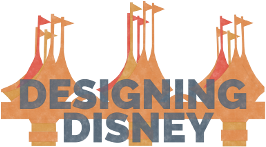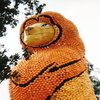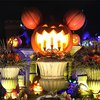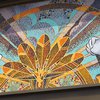Designing Studio 1 - Walt Disney Studios Park
Walt Disney Studios Park's 'Disney Studio 1' comprises several stores and restaurants, cleverly disguised behind no less than six different facades, giving the impression of a movie 'street'.

The facades are modeled on various Hollywood buildings - both real and imagined - from the 1920's to 1960's.

A close look at Hollywood, Disneyland Paris style, and Hollywood, California, USA, proves the similarities aren't just a special effect. Here are a few examples of how Walt Disney Imagineering delivered the Golden Age of movies to France.
Crossroads of the World - 'The Gossip Column'
6671 Sunset Boulevard.


Crossroads of the World was America's first outdoor shopping mall. It was designed by Robert V. Derrah in 1936.

The international shopping center featured a central building designed to resemble a docked ocean liner surrounded by a small village of two-story cottages done up in a variety of architectural styles. The ship's aft is crowned with a thirty-foot Art Deco tower capped with a lighted eight-foot world globe.

Today, the complex houses numerous small businesses such as design firms, production houses and talent agencies.

Did you know that Walt Disney Studio Park's "Parade Central" control room is located behind the Gossip Column & Last Chance Gas facades (on the second floor)?
The Darkroom - 'Shutterbugs'
5370 Wilshire Boulevard.


The Darkroom was a camera store on the Miracle Mile.
The store's facade is recognized as a rare example of Programmatic architecture - buildings that look like something else, a hot dog, say, or a hat. It was designed in 1938 by Marcus Miller to resemble a nine-foot-high Argus 35mm camera.

The actual camera piece still exists on Wilshire Boulevard. The original isn't a camera store anymore, it's a restaurant.
Schwab's Pharmacy
8024 Sunset Boulevard.


Schwab's Pharmacy was a drug store widely noted as a meeting place and 'headquarters' for working, or hoping-to-be-working, actors.
It was unique among local hot spots in that it welcomed business from all rungs of the film industry ladder. Struggling young performers could always drop in for a free meal.
Like many drug stores in the United States throughout the mid-twentieth century, Schwab's sold medicines and had a counter serving ice cream dishes and light meals.
The Swab's Pharmacy closed its doors in October 1983. The store was in financial peril. A few years later, the building came down, making way for a large retail complex.
The Brown Derby Restaurant
1628 North Vine Street.


The Brown Derby was the name given to a chain of restaurants in Los Angeles, California. The first was shaped like a men's derby hat.
The Hollywood Brown Derby on Vine Street, just south of Hollywood Boulevard, was the most famous of them all. On account of its proximity to nearby movie studios, it became the place where movie stars, celebrities of all types, the rich and the powerful gathered.

The building was largely destroyed by fire in 1987. Only a small fragment of the restaurant's facade remains, and is being incorporated into a new W Hotels development.

The cartoon sketches displayed in the Brown Derby section of 'Restaurant en Coulisse' at Studio 1 - Walt Disney Studios Park are copies of the drawings that were on display in the original Brown Derby in Hollywood.

Other little known facts
The Hep Cat Club facade pays homage to the jazz clubs of the 1950's made famous during the era of the "Rat Pack".

The Alexandria Theater has an elaborate exterior inspired by the colorful "Movie Palaces" that were a feature of Los Angeles from the 1920's through to the 1940's.
Hollywood and Vine Five & Dime facade is a nostalgic take on the small sundries stores that have been progressively replaced by department stores and supermarkets.

Above the facades hang two neon signs that add to the Hollywood atmosphere: "Carmen's Veranda" (a play on words relating to Carmen Miranda, the legendary Portuguese singer who was famous for her fruit-decorated turban), and "Coconut Groove", named after the celebrated Hollywood nightspot.
The acronym 'L.C.H.' has been stamped at the back of the timber sets. It refers to the original name of Studio 1: 'Lights! Camera! Hollywood!'.
Credits
Photos:
- Alexandre Rosa
- Scrooge








